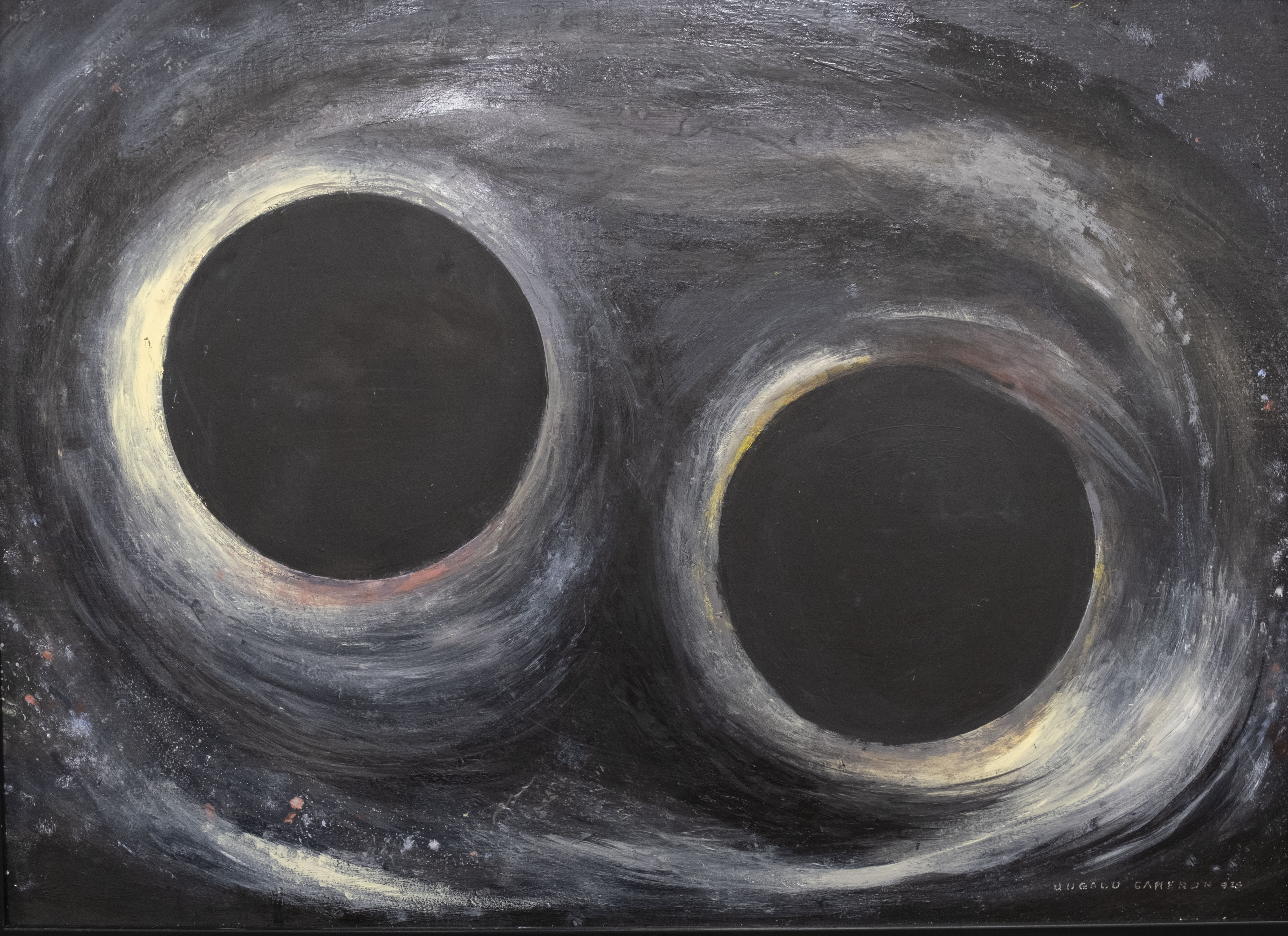New paintings celebrate University of Glasgow’s brush with cosmic history
Published: 3 November 2025
A Scottish artist has donated two new paintings to the University of Glasgow to celebrate the 10th anniversary of the first detection of gravitational waves.
A Scottish artist has donated two new paintings to the University of Glasgow to celebrate the 10th anniversary of the first detection of gravitational waves.
Professor Dugald Cameron created the artworks in recognition of the University’s role in the historic first detection of gravitational waves, made by the USA-based Laser Interferometer Gravitational-Wave Observatory (LIGO) on September 14th 2015.
Professor Cameron, a former director of the Glasgow School of Art who is currently a visiting professor at the University of Strathclyde, has presented the paintings to the University’s Institute for Gravitational Research.
The paintings, titled ‘Dawn: Window of a New Era in Understanding’, each measuring 30.25 inches by 22.25 inches and are painted in oils. They are designed to be displayed as a diptych, with one above the other.

The upper canvas shows two black holes in the final fraction of a second before they merge together, while the lower painting shows the twin LIGO observatories and a visualisation of the historic first gravitational wave signal they detected in 2015.
In the centre of the painting is one of the delicate silica suspension systems that hold the detector's mirrors in place and make the detections possible.
These systems were developed by University of Glasgow researchers in collaboration with colleagues at the Rutherford Appleton Lab, the University of Birmingham and Caltech.

At the bottom of the canvas, Professor Cameron has painted the eyes of Albert Einstein. Einstein first predicted the existence of gravitational waves in his general theory of relativity, published in 1916, but it took nearly a century to build a detector sensitive enough to observe the minute ripples in spacetime caused by massive cosmic events like the collision of black holes.
The paintings were created in close collaboration between Professor Cameron and researchers at the IGR.
Professor Sheila Rowan, director of the IGR, said: “We’re delighted to be accepting this generous gift from Dugald as part of our ongoing celebration of the 10th anniversary of the first detection. Helping him to understand the science of gravitational waves so that he could accurately capture the science on canvas has given us a new way to think about our research, and it’s fantastic that we’ll be able to display the paintings here in our Kelvin Building on campus.”
Professor Sir James Hough, who has worked on gravitational wave research at Glasgow since 1971 and founded the Institute for Gravitational Research in 2000, was closely involved in the artistic collaboration. He initially connected with Cameron through a shared interest in railway engineering.
Professor Sir James said: "Ten years on from the first detection of gravitational waves, the Ligo Scientific Collaboration has expanded to include the Virgo detector in Italy and the KAGRA detector in Japan, and we’ve made about 300 detections of gravitational wave signals. My colleagues and I worked closely with Professor Cameron over the course of three months, discussing how the concepts of gravitational waves could be represented in art, and the results do a stunning job of capturing the achievement of thousands of scientists from around the world working together to create the expanding field of gravitational wave astronomy."

(l-r) Professor Dugald Cameron; Professor Sheila Rowan, director of the University of Glasgow’s Institute for Gravitational Research, and Professor Sir James Hough pose with Professor Cameron’s artwork alongside a model of the mirror suspensions developed and built at the University of Glasgow which made LIGO’s historic first detection of gravitational waves possible
Professor Cameron, who was director of the Glasgow School of Art between 1991 and 1999, has used his time in retirement from a distinguished career in industrial design to celebrate Scottish excellence in science, engineering, and innovation through his artwork. He holds honorary degrees from both the University of Glasgow and the University of Strathclyde.
He said: “What is striking and satisfying to me is the truly international nature of the gravitational wave community particularly so in the dreadful times in which we live.
‘Over the years much of my work has tried to celebrate things Glaswegian and this diptych, two related pictures, might ,I hope, do this.
“I came to this entirely fresh, but under the tutelage of professors Sir James Hough and Sheila Rowan became fascinated with the subject and quest for the detection of these elusive phenomena coming to us from such an unimaginable distances.
“So how do you paint something you cannot see and what colour is the Universe? I have tried do give my take on this - the top picture is the Universe with two black holes in the process of merging giving rise to gravitational waves, ripples in spacetime and the lower, the various component involved in the search including the device created by the team at the University of Glasgow which plays a crucial role in leading to the first detection on 14 Sept 2015, thus proving Einstein right.
“It has been my pleasure to present my pictures to Sir James and the University of Glasgow.”
Earlier this year, researchers from the IGR also worked with the educational arts organisation Science Ceilidh to develop a Scottish Country Dance inspired by gravitational waves.
https://www.youtube.com/watch?v=SqhFtkQ4f2c
First published: 3 November 2025

